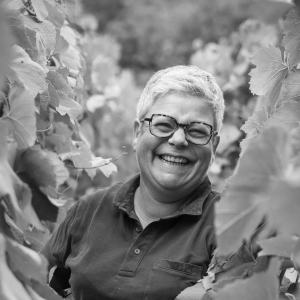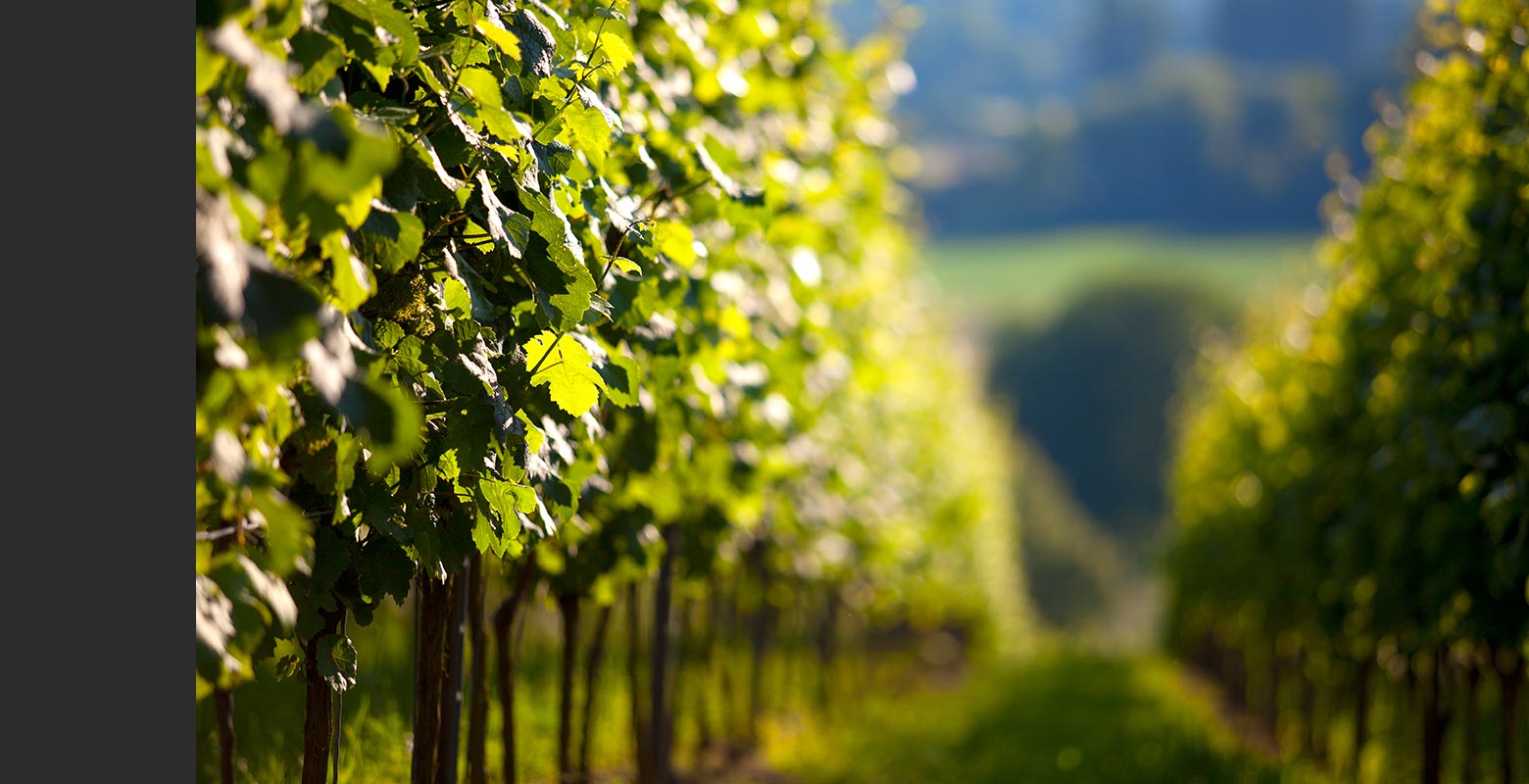
Sophie Labry
" La qualité d'un vin commence à la vigne "
Today, Sophie Labry is at the helm of the domaine located in Melin, near Auxey-Duresses. She is the third generation to work the family-owned vineyards.
She has continued to develop the domaine, respecting the savoir-faire of previous generations, whilst adapting to the challenges of the day and introducing her own touch of modernity and reinvention.
Her father, Bernard, still keeps an eye on the domaine. He monitors the ageing of the wines in the cellar, while Sophie looks after the terroirs and decides what work needs to be carried out in the vineyards.
“This approach allows me to fully understand the needs of the vine, and how to familiarise myself with each different type of soil”, the winemaker explains. “And I really love driving the tractor”, she adds mischievously, before offering a more serious thought: “Can one make good wine without good quality grapes?” Clearly not, the key to a good quality wine starts with the vine.
THE ESTATE
Over several generations the Labry family have passionately and energetically carved out the destiny of the family estate, at Melin, near to Auxey-Duresses, which lies between the Côte de Beaune and the Haut-Côtes de Beaune.
The property has been extended over the years and now covers 16 hectares, of which about 10 hectares of vines are trained in the lyre system, which produce the best quality wines. It was André Labry who established himself at Melin in 1948, and chose to specialise in viticulture. His forebears though practised mixed farming, based around Melin, La Roche-Pot and Baubigny. Bernard Labry, André's son, set up high-trained vines at the start of the 1970s, then he employed the lyre system at the start of the 1980s, as well as the use of grass cover. As a result of the regrouping of land led by André Labry between 1948 and 1986, their holdings are now relatively closely grouped compared to the average Burgundian plot; 22 blocks of cultivated land have become 13 hectares of vines over 5 districts.U
The estate principally produces Auxey-Duresses red and white, Bourgogne Hautes-Côtes de Beaune red and white, but also some Côtes de Beaune, Meursault villages and Monthélie 1er Cru.
Viticulture Raisonnée is the philosophy at the very heart and soul of this property. We believe the correct way to go forward is by closely monitoring the development of the vine and pests, and choosing the optimum moment to apply environmentally friendly products, in the most appropriate measure.

THE DOMAINE’S SPECIAL FEATURE: LYRE-TRAINED VINES
Sophie, a woman driven by her convictions and commitments, has fervently taken up one of her father’s causes: that vines should be trained in the lyre method. Since the property has been using the lyre system for over 30 years now, this is not out of eccentricity but through a steadfast conviction
Vines that are trained high - on the lyre system, in the shape of a ‘Y’ – are in a better position to harness the sun and allow grapes to fully ripen; in other words, an open canopy which allows the sun’s rays to reach the grapes. A vine trained on Lyre which thanks to low-density planting and to the height of the canopy, makes it easier for the rows to be sown with grass and also to reduce the applications of treatments (by around 50%).
Finally, the ease of being able to work in an upright position is one of the most surprising factors when taking the decision to work with this vine-training system. Mechanical handling of the vines is carried out with a classic orchard tractor, which has less harmful impact than with a modern version.
The result is there for all to see. The wines, abounding in generosity and suppleness, derive their flavour from the terroir and the fruit.
THE WINES
Wines characterised by their terroir yet with weight and freshness in perfect harmony. This sums up the wines, both whites and reds, from André and Bernard Labry’s estate. The wines have finesse, generosity and richness due to the grapes being harvested at optimum ripeness, and having being de-stemmed. Structure is also a key component as some of the wines are capable of ageing over several years.
Winemaking here is based on close monitoring of the grape’s maturation and the natural progress of the fermentation, thus avoiding the need for systemic intervention and allowing each bottle to be a true reflection of the vintage and of the appellation.
Maceration is quite long for the reds, at around 15 days or more, and is conducted in concrete tanks - traditionally left open - under temperature controlled conditions.
For the whites, monitoring the fermentation temperature is paramount.
Village and Premier Cru wines are wholly fermented and aged in wood. For the regional appellation, the wines are partially barrel-fermented and partially tank-fermented. In each case, it is important to weigh up the qualities of each appellation so as to justify the use of wood.

ADRESSE
Hameau de Melin - 135 route de Beaune
21190 AUXEY-DURESSES

Sophie Labry
" La qualité d'un vin commence à la vigne "
Today, Sophie Labry is at the helm of the domaine located in Melin, near Auxey-Duresses. She is the third generation to work the family-owned vineyards.
She has continued to develop the domaine, respecting the savoir-faire of previous generations, whilst adapting to the challenges of the day and introducing her own touch of modernity and reinvention.
Her father, Bernard, still keeps an eye on the domaine. He monitors the ageing of the wines in the cellar, while Sophie looks after the terroirs and decides what work needs to be carried out in the vineyards.
“This approach allows me to fully understand the needs of the vine, and how to familiarise myself with each different type of soil”, the winemaker explains. “And I really love driving the tractor”, she adds mischievously, before offering a more serious thought: “Can one make good wine without good quality grapes?” Clearly not, the key to a good quality wine starts with the vine.
THE ESTATE
Over several generations the Labry family have passionately and energetically carved out the destiny of the family estate, at Melin, near to Auxey-Duresses, which lies between the Côte de Beaune and the Haut-Côtes de Beaune.
The property has been extended over the years and now covers 16 hectares, of which about 10 hectares of vines are trained in the lyre system, which produce the best quality wines. It was André Labry who established himself at Melin in 1948, and chose to specialise in viticulture. His forebears though practised mixed farming, based around Melin, La Roche-Pot and Baubigny. Bernard Labry, André's son, set up high-trained vines at the start of the 1970s, then he employed the lyre system at the start of the 1980s, as well as the use of grass cover. As a result of the regrouping of land led by André Labry between 1948 and 1986, their holdings are now relatively closely grouped compared to the average Burgundian plot; 22 blocks of cultivated land have become 13 hectares of vines over 5 districts.U
The estate principally produces Auxey-Duresses red and white, Bourgogne Hautes-Côtes de Beaune red and white, but also some Côtes de Beaune, Meursault villages and Monthélie 1er Cru.
Viticulture Raisonnée is the philosophy at the very heart and soul of this property. We believe the correct way to go forward is by closely monitoring the development of the vine and pests, and choosing the optimum moment to apply environmentally friendly products, in the most appropriate measure.

THE DOMAINE’S SPECIAL FEATURE: LYRE-TRAINED VINES
Sophie, a woman driven by her convictions and commitments, has fervently taken up one of her father’s causes: that vines should be trained in the lyre method. Since the property has been using the lyre system for over 30 years now, this is not out of eccentricity but through a steadfast conviction
Vines that are trained high - on the lyre system, in the shape of a ‘Y’ – are in a better position to harness the sun and allow grapes to fully ripen; in other words, an open canopy which allows the sun’s rays to reach the grapes. A vine trained on Lyre which thanks to low-density planting and to the height of the canopy, makes it easier for the rows to be sown with grass and also to reduce the applications of treatments (by around 50%).
Finally, the ease of being able to work in an upright position is one of the most surprising factors when taking the decision to work with this vine-training system. Mechanical handling of the vines is carried out with a classic orchard tractor, which has less harmful impact than with a modern version.
The result is there for all to see. The wines, abounding in generosity and suppleness, derive their flavour from the terroir and the fruit.
THE WINES
Wines characterised by their terroir yet with weight and freshness in perfect harmony. This sums up the wines, both whites and reds, from André and Bernard Labry’s estate. The wines have finesse, generosity and richness due to the grapes being harvested at optimum ripeness, and having being de-stemmed. Structure is also a key component as some of the wines are capable of ageing over several years.
Winemaking here is based on close monitoring of the grape’s maturation and the natural progress of the fermentation, thus avoiding the need for systemic intervention and allowing each bottle to be a true reflection of the vintage and of the appellation.
Maceration is quite long for the reds, at around 15 days or more, and is conducted in concrete tanks - traditionally left open - under temperature controlled conditions.
For the whites, monitoring the fermentation temperature is paramount.
Village and Premier Cru wines are wholly fermented and aged in wood. For the regional appellation, the wines are partially barrel-fermented and partially tank-fermented. In each case, it is important to weigh up the qualities of each appellation so as to justify the use of wood.

ADRESSE
Hameau de Melin - 135 route de Beaune
21190 AUXEY-DURESSES



